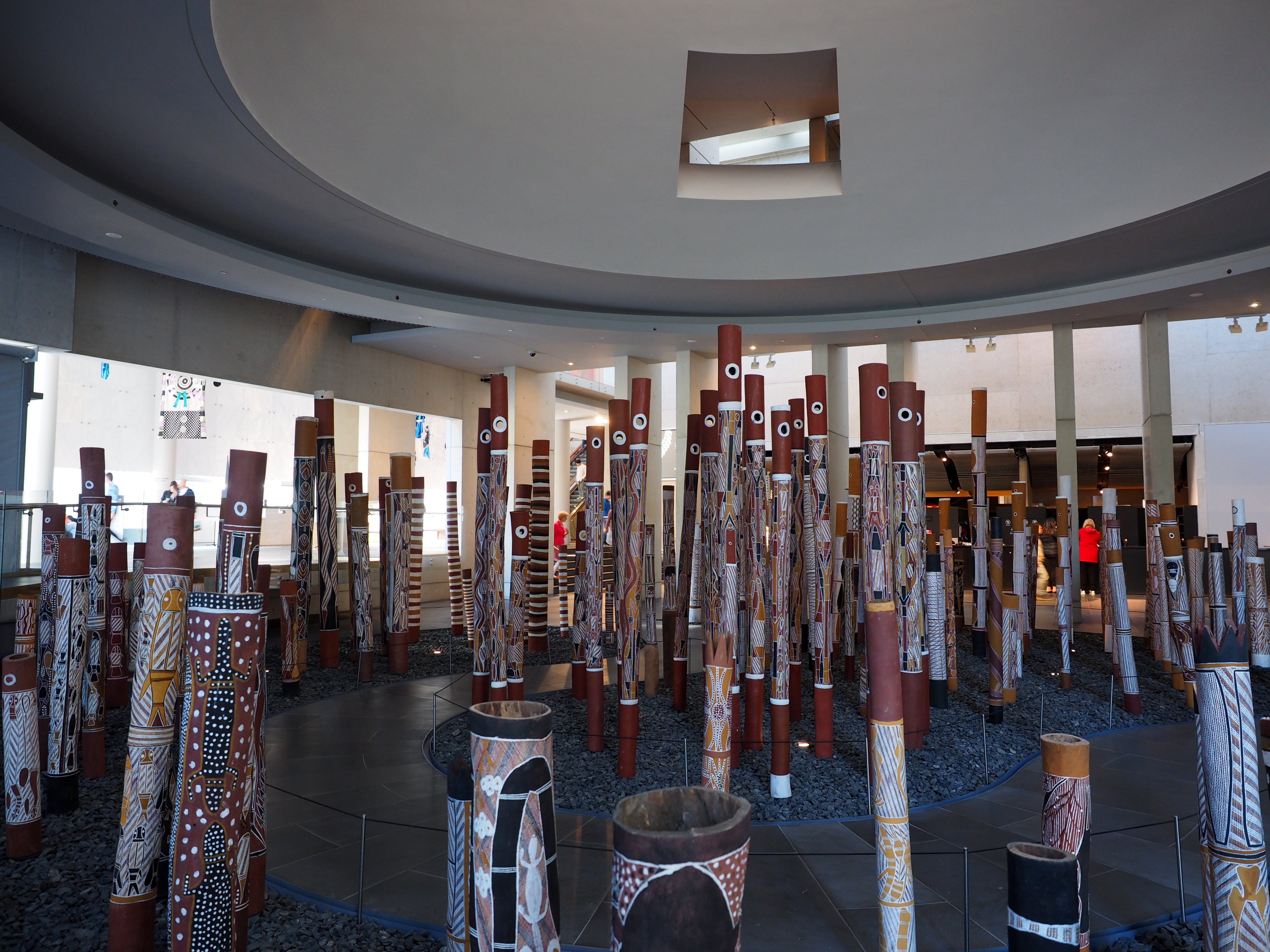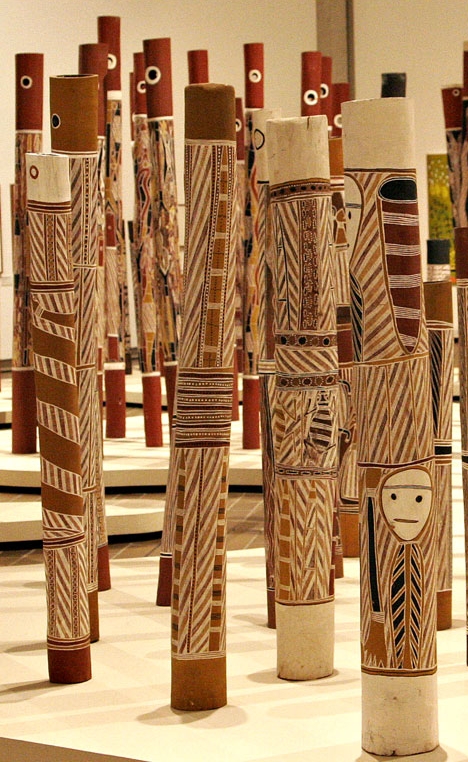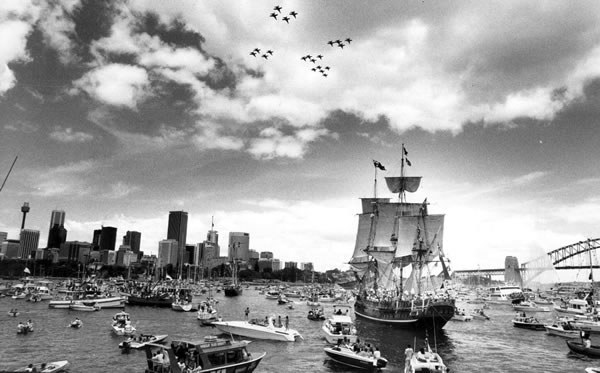|
David Malangi Daymirringu
David Malangi (192719 June 1999), also known as David Malangi Daymirringu, nicknamed Dollar Dave, was an Indigenous Australian Yolngu artist from the Northern Territory. He was one of the most well-known bark painters from Arnhem Land and a significant figure in contemporary Indigenous Australian art. He became known for his work being printed without his permission on the Australian one-dollar note, which led to a copyright dispute. Biography David Malangi was born in 1927 at Mulanga, on the east bank of the Glyde River in Central Arnhem Land, Northern Territory, where he received initiation into Manyarrngu culture during his early years spent in the area. Malangi was born into the Manharrngu, a small clan group known as the people of the mangroves. He moved with his parents at a young age to Milingimbi Island, where there was a recently established Methodist mission. He eventually settled at Yathalamarra waterhole, to which his wives and mother had connections, as Balmbi wom ... [...More Info...] [...Related Items...] OR: [Wikipedia] [Google] [Baidu] |
Northern Territory
The Northern Territory (abbreviated as NT; known formally as the Northern Territory of Australia and informally as the Territory) is an states and territories of Australia, Australian internal territory in the central and central-northern regions of Australia. The Northern Territory shares its borders with Western Australia to the west (129th meridian east), South Australia to the south (26th parallel south), and Queensland to the east (138th meridian east). To the north, the Northern Territory looks out to the Timor Sea, the Arafura Sea, and the Gulf of Carpentaria, including Western New Guinea and various other islands of the Indonesian archipelago. The NT covers , making it the third-largest Australian federal division, and List of country subdivisions by area, the 11th-largest country subdivision in the world. It is sparsely populated, with a population of only 249,000 – fewer than half the population of Tasmania. The largest population centre is the capital city of Darw ... [...More Info...] [...Related Items...] OR: [Wikipedia] [Google] [Baidu] |
Bula'Bula Arts
Ramingining is an Aboriginal Australian community of mainly Yolngu people in the Northern Territory, Australia, east of Darwin. It is on the edge of the Arafura Swamp in Arnhem Land. Wulkabimirri is a tiny outstation (homeland) nearby, and Murwangi, further south, is part of the Ramingining Homelands. Marwuyu Gulparil, also known as Gulparil Marwuyu or just Marwuyu, is another remote community to the south of Ramingining. History The community was established in the early 1970s, and became recognised as Aboriginal land with the passage of the ''Aboriginal Land Rights Act 1976''. The place name was registered as an administrative area in 2007. The village, along with nearby Murwangi (formerly Arafura Station, now part of Ramingining Homelands), was the source for many of the actors in the 2006 film ''Ten Canoes''. After the film sparked worldwide interest in Yolngu and Australian Aboriginal culture, a spin-off educational project known as ''Twelve Canoes'' was created, in coll ... [...More Info...] [...Related Items...] OR: [Wikipedia] [Google] [Baidu] |
Aboriginal Memorial
The ''Aboriginal Memorial'' is a work of contemporary Indigenous Australian art from the late 1980s, and comprises 200 decorated hollow log coffins (also known as memorial poles, dupun, ḻarrakitj and other terms). It was conceived by Djon Mundine, Djon (John) Mundine in 1987–88 and realised by 43 artists from Ramingining, Northern Territory, Ramingining and neighbouring communities of Central Arnhem Land, in the Northern Territory. Artists who participated in its creation included David Malangi and George Milpurrurru. The work was created to coincide with the Australian Bicentenary and commemorates those Indigenous Australians who died as a result of European settlement. It was acquired by the National Gallery of Australia, where it is on permanent display. Its first exhibition was at the Sydney Biennale in 1988, and it was the centrepiece of an exhibition of Indigenous art at Russia's Hermitage Museum in 2000. Creation In 1988, Australia marked 200 years since its first o ... [...More Info...] [...Related Items...] OR: [Wikipedia] [Google] [Baidu] |
Hollow Log Coffin
A memorial pole, also known as hollow log coffin, burial pole, lorrkkon, ḻarrakitj, or ḏupun, is a hollow tree trunk decorated with elaborate designs, made by the Yolngu and Bininj peoples of Arnhem Land in the Northern Territory of Australia. Originally used to hold the bones of deceased people or for burial ceremonies, they are now made as works of art. The permanent exhibit at the National Gallery of Australia, '' Aboriginal Memorial'', consists of 200 hollow log coffins, created by 43 artists. Terminology The poles are variously known as lorrkkon (in West Arnhem Land, Bininj Kunwok), ḻarrakitj (in the east), or ḏupun by the Yolngu people. The names derive from the name of the burial ceremony, also variously called djalumbu, badurru, mudukundja, mululu and larajeje. English names include hollow log coffins, burial pole, and memorial pole. Description and uses Hollow log coffins vary in size: those made for a burial ceremony are large, while smaller logs may ho ... [...More Info...] [...Related Items...] OR: [Wikipedia] [Google] [Baidu] |
Bicentenary Of Australia
The bicentenary of Australia was celebrated in 1988. It marked 200 years since the arrival of the First Fleet of British convict ships at Sydney in 1788. History The bicentennial year marked Captain Arthur Phillip's arrival with the 11 ships of the First Fleet in Sydney Harbour in 1788, and the founding of the city of Sydney and the colony of New South Wales. 1988 is considered the official bicentenary year of the founding of Australia. Celebrations The Australian Bicentenary was marked by pomp and ceremony across Australia to mark the anniversary of the arrival of the First Fleet of British ships at Sydney in 1788. The Australian Bicentennial Authority (ABA), pursuant to the Australian Bicentennial Authority Act 1980, was set up to plan, fund and coordinate projects that emphasized the nation's cultural heritage. State councils were also created to ensure cooperation between the federal and state governments. The result was a national programme of events and celebrations ... [...More Info...] [...Related Items...] OR: [Wikipedia] [Google] [Baidu] |
Sydney
Sydney is the capital city of the States and territories of Australia, state of New South Wales and the List of cities in Australia by population, most populous city in Australia. Located on Australia's east coast, the metropolis surrounds Sydney Harbour and extends about 80 km (50 mi) from the Pacific Ocean in the east to the Blue Mountains (New South Wales), Blue Mountains in the west, and about 80 km (50 mi) from Ku-ring-gai Chase National Park and the Hawkesbury River in the north and north-west, to the Royal National Park and Macarthur, New South Wales, Macarthur in the south and south-west. Greater Sydney consists of 658 suburbs, spread across 33 local government areas. Residents of the city are colloquially known as "Sydneysiders". The estimated population in June 2024 was 5,557,233, which is about 66% of the state's population. Estimated resident population, 30 June 2017. The city's nicknames include the Emerald City and the Harbour City. There is ev ... [...More Info...] [...Related Items...] OR: [Wikipedia] [Google] [Baidu] |
Art Gallery Of New South Wales
The Art Gallery of New South Wales (AGNSW), founded as the New South Wales Academy of Art in 1872 and known as the National Art Gallery of New South Wales between 1883 and 1958, is located in The Domain, Sydney, Australia. It is the most important public gallery in Sydney and one of the list of largest art museums, largest in Australia. The gallery's first public exhibition opened in 1874. Admission is free to the general exhibition space, which displays Australian art (including Indigenous Australian art), European and Asian art. A dedicated #Asian Art Gallery expansion, Asian Gallery was opened in 2003. History 19th century On 24 April 1871, a public meeting was convened in Sydney to establish an Academy of Art "for the purpose of promoting the fine arts through lectures, art classes and regular exhibitions." Eliezer Levi Montefiore (brother of Jacob Levi Montefiore and nephew of Jacob Barrow Montefiore, Jacob and Joseph Barrow Montefiore) co-founded the New South Wales Aca ... [...More Info...] [...Related Items...] OR: [Wikipedia] [Google] [Baidu] |
Biennale Of Sydney
The Biennale of Sydney is an international festival of contemporary art, held every two years in Sydney, Australia. It is a large and well-attended contemporary visual arts event in the country. Alongside the Venice and São Paulo biennales and Documenta, it is one of the longest running exhibitions of its kind and was the first biennale to be established in the Asia-Pacific region. History In 1973, Franco Belgiorno-Nettis, as co-managing director of Transfield Pty. Ltd., founded the Biennale of Sydney which held its first exhibition of 37 artists in the exhibition hall of the then newly opened Sydney Opera House. *1973, ''The Biennale of Sydney'', Coordinator: Anthony Wintherbotham *1976, ''Recent International Forms in Art'', artistic director: Thomas G. McCullough *1979, ''European Dialogue'', artistic director: Nick Waterlow *1982, ''Vision in Disbelief'', artistic director: William Wright *1984, ''Private Symbol: Social Metaphor'', artistic director: Leon Paroissien *1 ... [...More Info...] [...Related Items...] OR: [Wikipedia] [Google] [Baidu] |
Aboriginal Australian
Aboriginal Australians are the various indigenous peoples of the Australian mainland and many of its islands, excluding the ethnically distinct people of the Torres Strait Islands. Humans first migrated to Australia 50,000 to 65,000 years ago, and over time formed as many as 500 language-based groups. In the past, Aboriginal people lived over large sections of the continental shelf. They were isolated on many of the smaller offshore islands and Tasmania when the land was inundated at the start of the Holocene inter-glacial period, about 11,700 years ago. Despite this, Aboriginal people maintained extensive networks within the continent and certain groups maintained relationships with Torres Strait Islanders and the Makassar people of modern-day Indonesia. Over the millennia, Aboriginal people developed complex trade networks, inter-cultural relationships, law and religions, which make up some of the oldest, and possibly ''the'' oldest, continuous cultures in the world ... [...More Info...] [...Related Items...] OR: [Wikipedia] [Google] [Baidu] |
São Paulo Art Biennial
The São Paulo Art Biennial ( Portuguese: ''Bienal de São Paulo'') was founded in 1951 and has been held every two years since. It is the second oldest art biennial in the world after the Venice Biennale (in existence since 1895), which serves as its role model. History The Biennial was founded by the Italian-Brazilian industrialist Ciccillo Matarazzo (1898–1977). Since 1957, the São Paulo Biennial has been held in the Ciccillo Matarazzo pavilion in the Parque do Ibirapuera. The three-story pavilion was designed by a team led by architects Oscar Niemeyer and Hélio Uchôa, and provides an exhibition space of 30,000 m2. The São Paulo Bienal features Brazilian and international contemporary art and is one of South America's most important large-scale art exhibitions. After the completion of the 6th Biennial, the São Paulo Biennial Foundation was created to advance the exhibition, which until then had been organized by the Museu de Arte Moderna de São Paulo (MAM-SP). Th ... [...More Info...] [...Related Items...] OR: [Wikipedia] [Google] [Baidu] |
Copyright In Australia
The copyright law of Australia defines the legally enforceable rights of creators of creative and artistic works under Australian law. The scope of copyright in Australia is defined in the ''Copyright Act 1968'' (as amended), which applies the national law throughout Australia. Designs may be covered by the ''Copyright Act'' (as sculptures or drawings) as well as by the '' Design Act''. Since 2007, performers have moral rights in recordings of their work. Until 2004, copyright in Australia was based on the plus 50 law, which restricts works until 50 years after the author's death. In 2004 this was changed to a plus 70 law in line with the US and European Union, but this change was not made retroactive (unlike the 1995 change in the European Union which brought some, e.g. British authors, back into copyright). The consequence is that the work of an Australian author who died before 1955 is normally in the public domain in Australia. However the copyright of authors was extended t ... [...More Info...] [...Related Items...] OR: [Wikipedia] [Google] [Baidu] |
Reserve Bank Of Australia
The Reserve Bank of Australia (RBA) is Australia's central bank and banknote issuing authority. It has had this role since 14 January 1960, when the ''Reserve Bank Act 1959'' removed the central banking functions from the Commonwealth Bank. The bank's main policy role is to control inflation levels within a target range of 2–3%, by controlling the unemployment rate according to the 'non-accelerating inflation rate of unemployment' (NAIRU) by controlling the official cash rate. The NAIRU was implemented in most western nations after 1975, and has been maintained at a target of 5–6% unemployment. The average unemployment rate in Australia between the end of the Second World War and the implementation of the NAIRU was consistently between 1 and 2%. Since the implementation of the NAIRU, the average unemployment rate in Australia has been close to 6%. The RBA also provides services to the Government of Australia and services to other central banks and official institutions. The ... [...More Info...] [...Related Items...] OR: [Wikipedia] [Google] [Baidu] |






